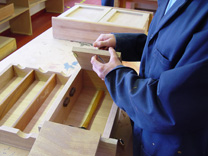themes
themes
Page 2
1 | 2 | 3 | 4
Skills Training and Social Enterprise
Carpentry training was another trade taught at Kibble. We do not have records to tell us exactly when this started but joinery shops were certainly established by 1907 and continued throughout the twentieth century, at least until the 1970s.
The period 1885-1932, known as the “Protective Era” represented a distinct shift of emphasis, and legislation in this period essentially demonstrated the goal of protecting children from adult work, legal processes and adult cruelty, and from some of the worst effects of adult poverty. In other words, it indicated a move away from justice-based to welfare-based models.
Farm Training and Social Enterprise
Moss farm was established in 1868 when Kibble leased fifteen acres of ground, and farming and gardening work was well established at Kibble by the early twentieth century. This provided another training opportunity for the boys, many of whom carried on with farm work both here and abroad when they left Kibble. It was also a social enterprising operation, as it met some of the centre’s own food needs as well as selling produce to the local community, thereby generating income that could be re-invested in Kibble. In addition to working on Kibble’s own farmland boys were also engaged in work on outside farms, carrying out potato picking and raspberry picking, for example.
Practical farm work was supplemented by lessons in agricultural theory in areas such as dairying and poultry. Mr Leitch of the Agricultural College in Glasgow gave several series of lectures in these subjects between 1910 and 1912.
Mark, one of our oral history interviewees told us that he learned a great deal about farming during his time at Kibble in the late 1940s and early 1950s, working on Kibble’s own farm and at neighbouring farms. The work must have been physically demanding as Mark told us that digging of fields was often done by boys using only spades and ploughs were pulled by boys before the use of horse-drawn ploughs became common place. Mark is now retired but spent the rest of his working life in farming after leaving Kibble and still has a great passion for agriculture.
Other oral history interviewees from our staff remember the farm shop selling produce to the local community during the 1960s and 1970s:
‘And every Friday, they used to sell the produce and you would have folk fae all over the Short Roods, Springbank Road, Greenock Road area. They were down there wi’ prams, bogeys – everything. And they used to go in there and they used to get cabbage, turnip, carrots, big bag of tatties, you know? £2 or somethin’, you know, a pound, two pound… pure fresh, I mean it was just pulled out the ground. It was only probably cut that morning or the morning, you know, the day before. But och it was amazin’…whit they made off it paid for whit they didnae have, you know for food within the school, you know?’
(Sam Hill, Carpentry Instructor at Kibble 1963-1995, interviewed by Elaine Harris 19/08/2005)
Sam also stated in his interview that the school had two thousand hens, a herd of dairy cattle, and a herd of beef cattle, which was kept on a farm rented by the school at Beith.
